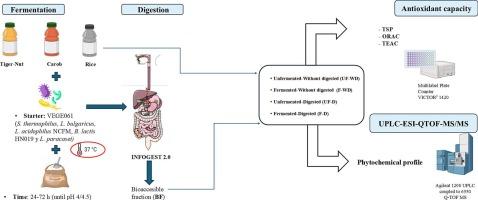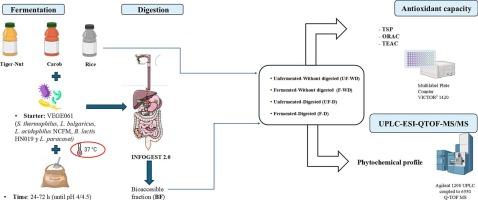Impact of fermentation and in vitro gastrointestinal digestion on the bioaccessibility of phytochemicals and antioxidant capacity of tiger nut, carob and rice beverages
IF 9.8
1区 农林科学
Q1 CHEMISTRY, APPLIED
引用次数: 0
Abstract
This study unveils the transformative effects of lactic acid fermentation and in vitro digestion on the phytochemical profile (UHPLC-QTOF) and antioxidant capacity (total polyphenols, TEAC and ORAC) of plant-based beverages made from local crops. Fermentation with the probiotic consortium VEGE061 and subsequent INFOGEST 2.0 digestion triggered antioxidant changes. Tiger nut beverages showed a dramatic increase in ORAC activity (1.8–4.0 mmol L−1 Trolox) while preserving polyphenol levels, with the b-isomer of hydroxyoleic acid exhibiting high potential bioaccessibility (>90 %) and sinapoyl alcohol stability improving markedly. Carob beverages displayed elevated polyphenol content (348–413 mg GAE/L) and TEAC activity (1.9–2.3 mmol L−1 Trolox), with 3-propyl malic acid bioaccessibility rising from 10 % to 64 % with fermentation. Rice beverages displayed modest improvements. Overall, digestion severely reduced phenolic stability (∼8 % retention), highlighting the urgent need for strategies to improve the bioaccessibility and maximize health benefits. These findings open new avenues for innovative functional beverage design.


发酵和体外胃肠消化对虎坚果、角豆豆和大米饮料中植物化学物质生物可及性和抗氧化能力的影响
本研究揭示了乳酸发酵和体外消化对由当地作物制成的植物性饮料的植物化学特征(UHPLC-QTOF)和抗氧化能力(总多酚、TEAC和ORAC)的变革性影响。益生菌联盟VEGE061发酵和随后的INFOGEST 2.0消化引发了抗氧化变化。虎坚果饮料在保持多酚含量的同时,ORAC活性显著提高(1.8-4.0 mmol L−1 Trolox),羟基油酸b-异构体具有较高的生物可及性(>90 %),sinapoyl醇稳定性显著提高。角豆饮料的多酚含量(348-413 mg GAE/L)和TEAC活性(1.9-2.3 mmol L−1 Trolox)均有所提高,3-丙基苹果酸的生物可及性从10 %提高到64 %。米饮料表现出适度的改善。总的来说,消化严重降低了酚的稳定性(~8 %保留率),这表明迫切需要提高生物可及性和最大化健康效益的策略。这些发现为创新功能性饮料设计开辟了新的途径。
本文章由计算机程序翻译,如有差异,请以英文原文为准。
求助全文
约1分钟内获得全文
求助全文
来源期刊

Food Chemistry
工程技术-食品科技
CiteScore
16.30
自引率
10.20%
发文量
3130
审稿时长
122 days
期刊介绍:
Food Chemistry publishes original research papers dealing with the advancement of the chemistry and biochemistry of foods or the analytical methods/ approach used. All papers should focus on the novelty of the research carried out.
 求助内容:
求助内容: 应助结果提醒方式:
应助结果提醒方式:


